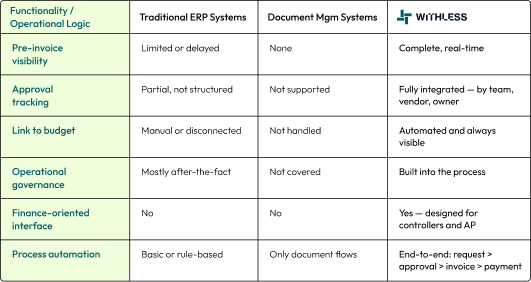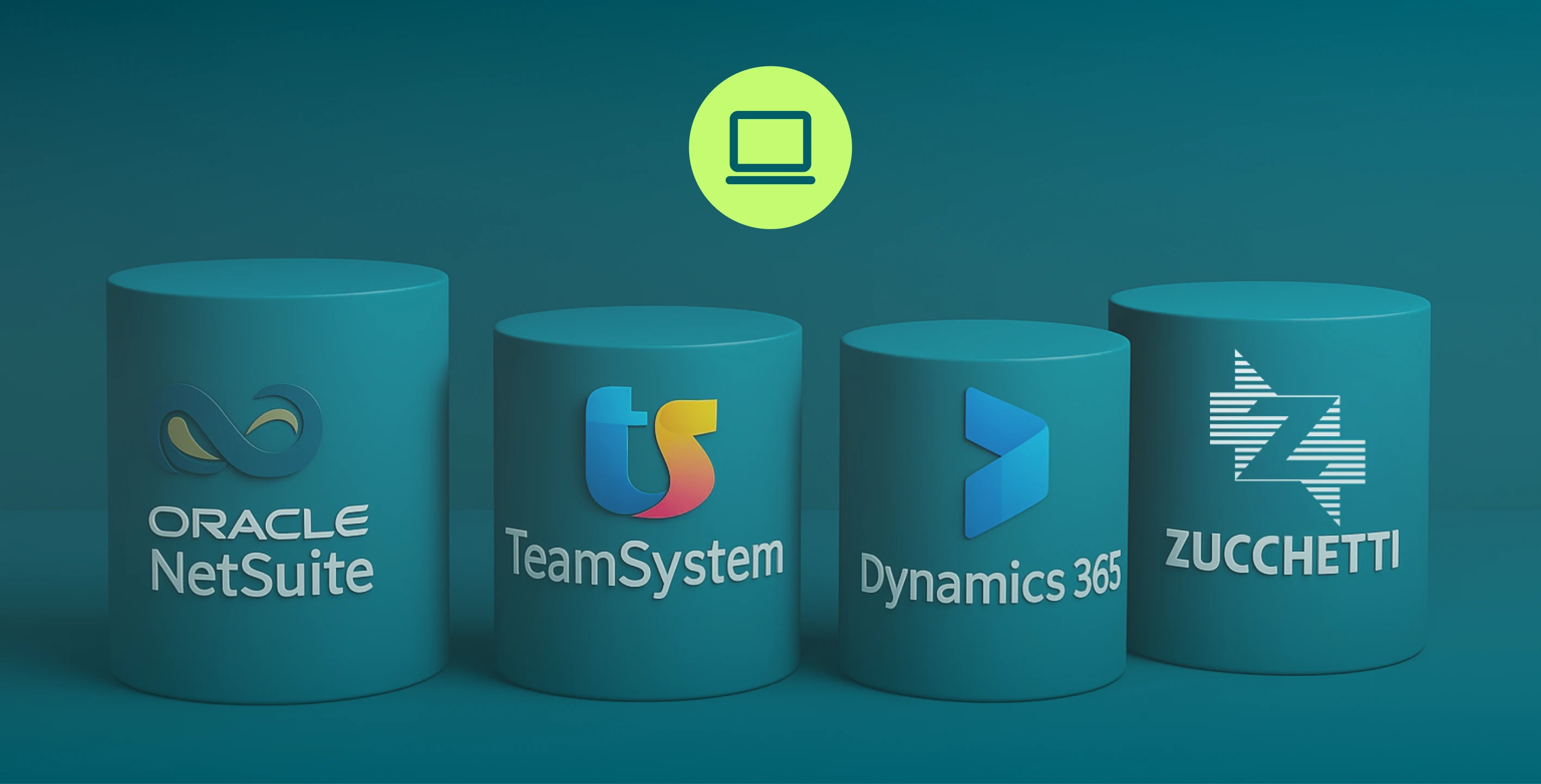How automation actually improves the procure-to-pay process
Automation streamlines the procure-to-pay process, speeds up approvals, and reduces errors. Learn how to gain real-time control and visibility.

In many European companies, the procure-to-pay process is still opaque, manual, and scattered across too many systems. Yet every euro that goes out should be traceable, budgeted, and justified — in real time.
P2P teams know the problem: delayed approvals, duplicate invoices, misaligned budgets, vendors chasing payments. The result? Costs spiral and visibility comes too late — often not until month-end close.
E-invoicing and document digitalisation may be mandatory. But they don’t fix the process. What’s missing is operational structure. And control.
That’s why we built WithLess: to bridge the gap between finance and the rest of the company and give teams real-time control over every step of the procure-to-pay process.
In this article, we explore what true automation looks like, which pitfalls to avoid, and why it’s no longer just a matter of efficiency — but of financial governance.
What the procure-to-pay process really is (and why it goes beyond accounting)
In standard definitions, procure-to-pay is often reduced to a linear set of tasks: — invoice in, invoice out. But finance teams working close to operations know it’s much more than that.
A proper procure-to-pay process covers the entire flow of outbound spend: from purchase request to payment execution. That includes approvals, reconciliation, budget checks, and a full audit trail — all mapped across cost centres, vendor policies, teams, and forecast plans.
Discussing accounts payable without addressing governance or spend control is like describing a balance sheet without its liabilities section. The real complexity is operational. If the process isn’t controlled upstream, companies face unexpected spend, misaligned flows, and compliance risks.
It’s still common to assume that digitising an invoice solves the problem. But digitalisation is not automation — and certainly not control. Dematerialising a document doesn’t prevent overspending, unclear approvals, or late-stage firefighting.
Finance needs systems that think like finance: systems that track every transaction from the moment spend is created, not when the invoice lands. Systems that connect approvals, budget logic, and vendor ownership in one operational flow.
What’s broken today — and why e-invoicing isn’t enough
In most companies, the real issue with the procure-to-pay process isn’t the invoice. It’s everything that happens before it.
When we designed WithLess, we started from this: fragmented workflows, opaque processes, and approval decisions lost in tools that were never built for finance.
Approvals scattered across emails, chats, and spreadsheets. Budgets not connected to cost centres. No structured vendor management. And invoices that reach accounting only when it’s too late to intervene.
And this way of running procure-to-pay comes at a cost: delays, errors, duplicate payments, missed early-payment discounts, blocked suppliers. Often, no one knows whether a transaction was ever approved — or if it was even in budget to begin with.
That’s not a process. It’s reactive admin.
Digitising documents helps — but it doesn’t solve the core issues. To really control the procure-to-pay process, structure needs to start upstream: when spend is initiated, not when the invoice is received.
Legacy systems and ERPs cover the accounts payable ledger, but overlook what comes before it: who requested the spend, why, with what urgency, and how it impacts the budget.
They work for posting entries. Not for approving spend. And definitely not for governing it in real time.
The result? No operational visibility. No actionable control.
To fix this, companies need more than a document archive. They need a system that links approvals, budgets, and vendors in a single flow — where every transaction is trackable from its origin, and every team sees what’s being spent before it hits the books.
How automation fixes the procure-to-pay process — not just speeds it up
A robust system assigns clear responsibilities, embeds approval logic based on budget availability, and links every invoice to the spend that generated it. No grey areas. No late-stage checks. No gaps between decision and execution.
That’s why at WithLess, we don’t just speed up the workflow. We rewire it. We build systems that connect every part of the procure-to-pay process: approvals, budgets, cost centres, vendors. For us, automation means reshaping the structure — not just making manual work faster.
Teams that automate their procure-to-pay process gain much more than efficiency. They reduce errors, prevent duplicates, eliminate overlaps between departments — and, most importantly, establish real governance. Budget control stops being an afterthought. It becomes part of the process itself.
Most generalist tools only cover the tail end: invoice processing, ledger posting, payment runs. But they ignore the upstream logic — approval chains, purchase justification, vendor terms, allocation to the right cost centre.
Take a simple example: tax authorities may show you which invoices were received. But they won’t tell you who approved them, under what conditions, or how they impact your forecast. That’s not operational control. That’s paperwork.
With WithLess, every invoice, approval and budget lives in the same flow. Each transaction follows clear rules. Each exception is flagged. And each spend has an accountable owner — before it hits your books.
The blind spot in generalist software
Most tools used to manage procure-to-pay were never designed for it.
ERP systems were built to maintain ledgers — not to provide operational visibility. They record what happened after the fact, but offer no insight into who approved the spend, why it was needed, or whether it aligned with budget.
Document management systems focus on compliance and archiving. They receive and store invoices — via email, e-invoicing platforms, or automated import. But they stop at the document. They don’t capture the approval flow, priority, or budget logic behind the transaction.
They automate paperwork. Not process.
What’s missing is a control engine — something that connects vendors, cost centres, and ownership into a coherent framework. Without that, there’s no way to govern the procure-to-pay process effectively.
With WithLess, every approval is tracked. Every spend is linked to the correct cost centre. Every decision is documented — before the invoice gets recorded.
And all of it lives in a single interface, where finance and business teams operate on the same information, with the same logic.
What automation really delivers
Controlling the procure-to-pay process isn’t just about efficiency. It’s a direct investment in accounting accuracy, operational governance, and cash flow sustainability.
With WithLess, every stage of the process is designed with accounting logic and operational visibility in mind. We don’t just digitise documents — we automate the decision flows that finance teams rely on. And we give them the tools to lead the process, not chase it.
Here’s what changes, WithLess:
- Every approval is tracked. The interface shows who authorised the spend, when it was approved, and which cost centre it was assigned to.
- Every budget is connected to operations. Purchase requests are authorised only if aligned with the remaining budget, and any variation is logged and audit-ready.
- Every invoice is reviewed before it hits the ledger. All accounting fields are pre-validated — no need to wait for AP to uncover issues after the fact.
- Every team has visibility over their requests and ownership. No duplicates, no overlap, no excuses.
- Control becomes part of the process. Automation speeds things up — but more importantly, it creates structure.
Digital archiving and compliance are essential — but not enough. An operational control system must also make the logic behind each spend visible, not just the document itself.
That’s why we built WithLess. It’s not an ERP. It’s not a filing system. It’s a platform designed for those who need full visibility, control, and coherence between finance and operations. Built for procure-to-pay, but designed to impact every decision that leads to spend.
And yes — it gives finance teams real time back.

The best time to automate your procure-to-pay process is now
Procure-to-pay isn’t just a back-office task to speed up. It’s a critical process that determines, every day, whether the company is spending in a coherent, predictable, and sustainable way. Yet in most organisations, it remains the most neglected: fragmented, manual, and invisible.
Automation isn’t just about document digitalisation. It’s about full traceability — from the initial request to the accounting entry — with consistency across the chart of accounts and the allocated budget.
That’s what gives finance teams time back. And that’s exactly why we built WithLess.
Want to see what real P2P automation looks like? We’ll show you how we do it — every day.
FAQs
What is the procure-to-pay process?
The procure-to-pay process (P2P) is the end-to-end flow companies use to manage their supplier spend. It covers every step from the initial purchase request to the final payment — including internal approvals, budget validation, invoice processing, and accounting.
What are the main steps in procure-to-pay?
The P2P process typically includes:
- Purchase request
- Approval
- Purchase order (PO) creation
- Goods or service delivery
- Invoice receipt
- Three-way matching or validation
- Posting to accounts payable
- Payment execution
How is procure-to-pay different from accounts payable?
Accounts payable is a key part of the P2P process, but it only covers the final stages: invoice handling, ledger posting, and payment.
Procure-to-pay starts earlier — with approvals, budgets, and vendor coordination — to ensure every spend is controlled from the moment it’s created.
What does a procure-to-pay team do?
P2P teams coordinate and manage the full lifecycle of supplier transactions. This includes validating purchase requests, ensuring budget availability, tracking approvals, processing invoices, and supporting payment runs — all while maintaining auditability and policy compliance.
What is included in the procure-to-pay process?
All business spend involving external suppliers: SaaS, services, consulting, contracts, materials, logistics — any purchase that results in an invoice.
P2P manages these flows from planning and authorisation through to accounting and payment.
What does accounts payable mean in the P2P process?
Accounts payable refers to the accounting function that records and pays supplier invoices. Within the P2P process, it handles invoice validation, cost centre allocation, tax compliance, and payment preparation.
The smartest way to manage business spend.
WithLess uses AI to control spend in real time, automate finance ops, and eliminate manual work.
Let's talk

